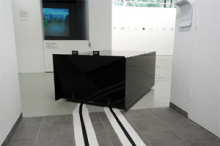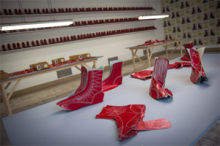Production Lines
There are many examples of artists referencing the aesthetics, repetition and persistence of production lines. But when discussing artwork in relation to production lines, it’s hard not to also think about the working methods of artists and their manufacturing practices. in this blog I have highlighted projects that reference the factory production line directly in content and also more indirectly in process - the projects chosen all rely on the work of others in some way. Cohen Van Balen employ actual factory workers to perform their piece, Paul Granjon enlists volunteers from the local community, Carlos Amorales wants the gallery visitor to manufacture the art, and István Csákány makes his artwork so delicate that it relies on constant maintenance from gallery technicians.
Many artists employ the skills of others to manufacture their art, acting as overlookers; they reside over a project, taking full intellectual authorship over it, but enlisting workers to do much of the making. With a clear distinction between physical work and intellectual work, labour can be divided into separate skill stations in order to increase production speed and quality.
But what about when artists use unskilled labour, as is usually the case when enlisting volunteers, or gallery goers? There is clearly more going on than just exploitation. Relying on others is problematic, especially when the successful completion of a project relies on the work of unskilled, unpaid workers.
The term ‘carry the can’ is thought to derive from cotton mills, as it was someone’s responsibility to physically move the partly processed cotton from one part of the mill to the next. Although basic unskilled labour, it carried a great deal of responsibility as workers relied on being supplied with product in order to do their work; if a link in the chain was broken it effected everything in front of it.
In Oriel Factory, Paul Granjon is the classic socially engaged artist, trying to give something back to the local community. He has relinquished control over the project in order to maximise the experience of others. The workers are taught skills and are free to define their own tasks and product. The artist’s responsibility has shifted from a pure making role to a managing one; he takes responsibility not only for the creation of a successful exhibition but also for providing a beneficial experience to others. If the unskilled, unpaid workers neither perform nor benefit, the project surely fails. Although, the intellectual labour is still clearly defined (the participants take authorship over their own pieces and these are displayed in a separate part of the gallery), the physical content of the final exhibition is left unknown until the worker’s labour is realised.
In the case of Flames Maquidadora by Carlos Amorales, the unskilled labourer is not an enlisted participant but the gallery goer. The artwork is the process of making in the gallery context and the gallery goer experiences the art through making it. By purposefully hinging an artwork on a potentially unwilling participant, Amorales seems to be highlighting the problems with relinquishing control to an unskilled workforce. This is played out by the fact that the visitors didn’t manage, even collectively, to produce one finished product.
In the spinning rooms of cotton mills, the person in charge was the spinner. He was the only person actually paid by the mill owner and would then enlist workers to help him, paying them out of his salary.
István Csákány is also handing over responsibility in Ghost Keeping, but this time to his advantage. The art world, like a factory, involves different people taking responsibility for different aspects of a project, and the different parts having different pockets of money. Artists often get commissioning fees which cover both payment for time and manufacturing cost. What so often happens is that artists have to sacrifice part of their payment in order to put more money into the manufacturing costs, therefore essentially working for a minimal wage. In Ghost Keeping, Csákány is capitalising from this system by manufacturing the work using very cheap materials that are easy to shape quickly. This then transfers the major cost of the project onto the artwork’s upkeep. This maintenance cost would come from an entirely different budget, and would be the responsibility of the gallery, not the artist.
The Owl Project do a similar thing with their iLog Workshops, by taking the responsibility of making from themselves and giving it to the collector. Instead of just paying for a piece of artwork, the collectors have to come to the artists’ studio and make it for themselves. They go away with an Owl Project artwork, but the Owl Project haven’t made it, they have. This model bypasses the problems with enlisting unskilled labour faced by artists such as Granjon. If the artwork doesn’t get made properly, or even completed, the consequences lie on the maker/collector, not the artists.
In 75 Watt by Cohen Van Balen it is not the artist’s but the labourer’s responsibility that has completely shifted. Instead of acting as 'man-machines', they are now performers. Just like the actual machines discussed in my last blog, by not accomplishing anything, the act of working becomes exposed. Although any artwork referencing production lines is clearly commenting on issues surrounding capitalism, workers rights, distribution of wealth and the general socioeconomic situation, it seems questions around the labour of artists also emerge. The factory worker and the artist seem immediately completely at odds, with artists generally being from more educated, affluent backgrounds, and not having to work to a strict pattern or production speed. But unlike an office worker, or indeed most other jobs outside the manufacturing sector, artists are actually involved in the production of a finished object (in the loosest sense of the word). In 75 Watt similarities to the work of artists are clear; the worker/performer carries out the action of making, produces a useless item, only to begin the unavailing activity again.







